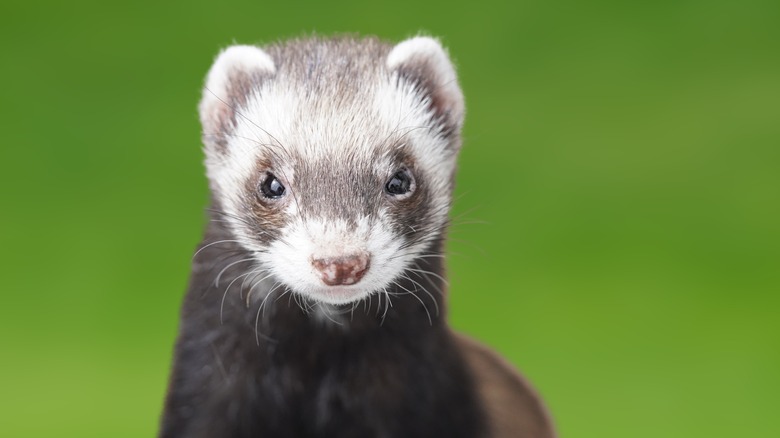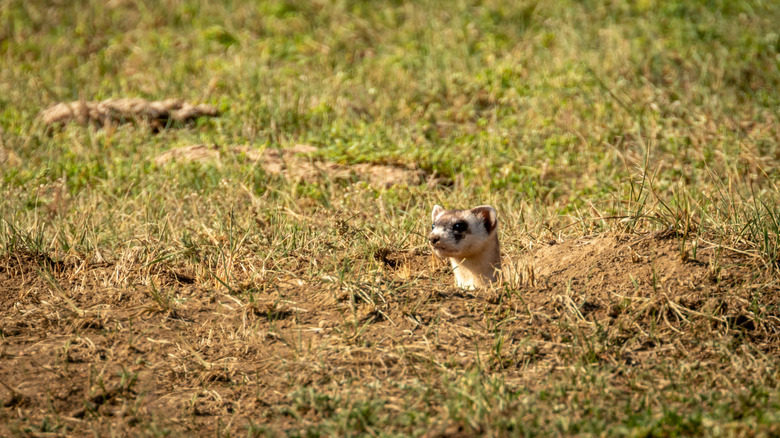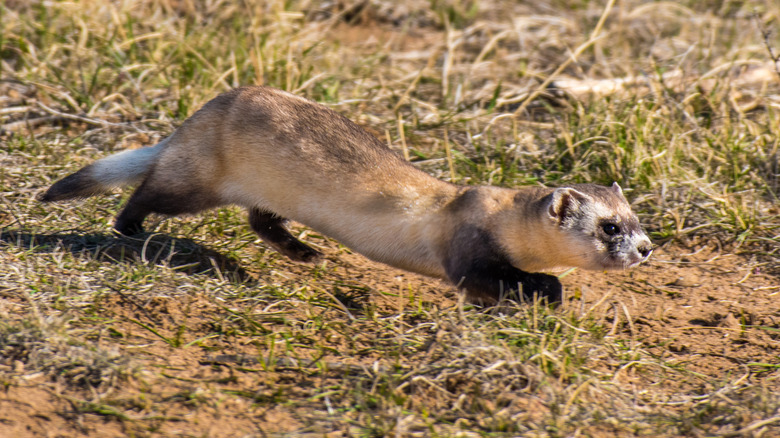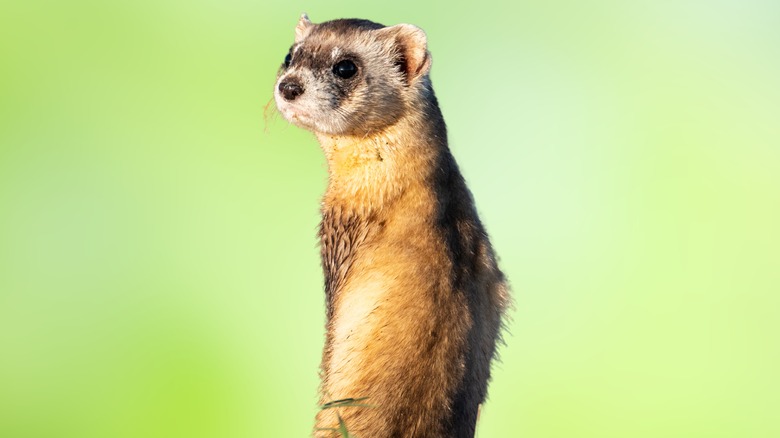The Remarkable Comeback Story For One Of North America's Most Endangered Mammals
North America's rarest mammal was thought to have gone extinct, not once, but twice, and yet today, it is having a remarkable comeback. The black-footed ferret (Mustela nigripes) is the continent's only native ferret species. It is small and sleek, ranging in length from a foot and a half to 2 feet. Black-footed ferrets were once a prominent species of the Great Plains, with as many as a million individuals living in the prairies up until the end of the 19th century, but then, things took a turn for the worse.
Black-footed ferrets are well-adapted to their environment, possessing incredible senses of sight, smell, and hearing, but they were never equipped to face the threat of humans. After Europeans settled North America and began aggressively moving westward across the country, life on the American prairie was upended. The fertile land of the Great Plains was converted into farms, taking land away from wildlife. The newly arrived farmers were especially at odds with the local prairie dog population. The burrowing rodents were seen as pests, and vast numbers of them were killed to make way for crops.
You might wonder what this all has to do with black-footed ferrets. Prairie dogs make up 90% of a black-footed ferret's diet, with a single adult ferret eating 100 prairie dogs or more each year. When 95% of the prairie dog population was killed off, black-footed ferrets faced the threat of starving to extinction, and for years, people thought they had.
How black-footed ferrets defied the odds
During the early-1900s, prairie dogs were poisoned and shot en masse to eliminate their presence on American farmland. Black-footed ferrets went down with them, and by the end of the 1950s, it was generally believed that the species had gone extinct. But in 1964, a small community of black-footed ferrets was discovered in South Dakota, prompting an effort to breed and repopulate the species. This experiment was unsuccessful, however, and in 1979, the last of the South Dakota ferrets died. The species had definitely gone extinct this time, or so scientists believed.
Then, in 1981, a remarkable discovery was made. The owners of a farm in Meeteetse, Wyoming, were shocked when their dog Shep brought them a gift in the form of a dead ferret. They took it to a local taxidermist, who recognized the species' characteristic black feet and eye mask. Wildlife researchers arrived at the farm to discover a community of 130 ferrets, but there was also a major problem. Disease was spreading amongst the ferrets, and over the next six years, all but 18 of them died. At that point, scientists captured all of the survivors and began breeding them in captivity. They were hoping to pull off a miracle similar to the bison reintroduction programs undertaken in both the U.S. and Canada. Nearly four decades later, and that small pool of 18 survivors has blossomed into a multi-state community of thousands of ferrets.
The challenges still facing black-footed ferrets
There are now multiple black-footed ferret breeding programs in place, including a federally sponsored effort at the Smithsonian Conservation Biology Institute, which maintains a steady population of 280 breeding-aged ferrets. Since repopulation efforts began, roughly 4,500 black-footed ferrets have been released into the wild. As of the writing of this article, there are ferret reintroduction sites in eight states: Wyoming, South Dakota, Montana, Arizona, Colorado, Utah, Kansas, and New Mexico. The prairie dog population in the Great Plains has also been making a comeback. Although two of the five North American prairie dog species are still endangered, the other three are now considered of least concern.
Despite these great strides, black-footed ferrets still face significant challenges in the form of diseases introduced to their native habitat by human activities. The most notable of these is sylvatic plague, a form of the bubonic plague, the force behind one of the worst disease epidemics in history. Fortunately, there is now a vaccine that has been proven to effectively prevent black-footed ferrets from contracting the plague. Every ferret released through breeding programs around the country receives this vaccine before entering the wild; however, preventing the disease from spreading amongst wild-born ferrets presents would be incredibly difficult to do as the population expands.
Cloning is the latest breakthrough in ferret repopulation efforts
The 2020s have brought potentially the biggest breakthrough in the effort to restore the black-footed ferret population: ferret clones. Back in 1988, scientists took a DNA sample from one of the original Meeteetse ferrets, a female named Willa, and froze it, hoping that someday there would be sufficient technology to make a clone. This finally came to pass in 2020 with the birth of Elizabeth Ann, the first ever successful clone of an endangered North American species.
As of the writing of this article, Elizabeth Ann is still alive, and at 4 years old, she's made it to the upper end of the average black-footed ferret lifespan. It turned out that Elizabeth Ann could not give birth, but a second clone of Willa named Antonia, proved capable. In November of 2024, the U.S. Fish and WIldlife Service announced that Antonia had given birth to three kits. One died shortly after birth, but the remaining two, a girl and boy named Sibert and Red Cloud, have proven to be healthy.
Creating a new genetic line from Willa's DNA would be a game-changer for saving the black-footed ferret. All of the ferrets released by breeding programs thus far descend from just seven individuals, but Willa, who had no children in her life, was not one of them. If Sibert and Red Cloud, as well as other clones like Antonia, can give birth to a new line, it would inject much needed genetic diversity into the resurgent population.



